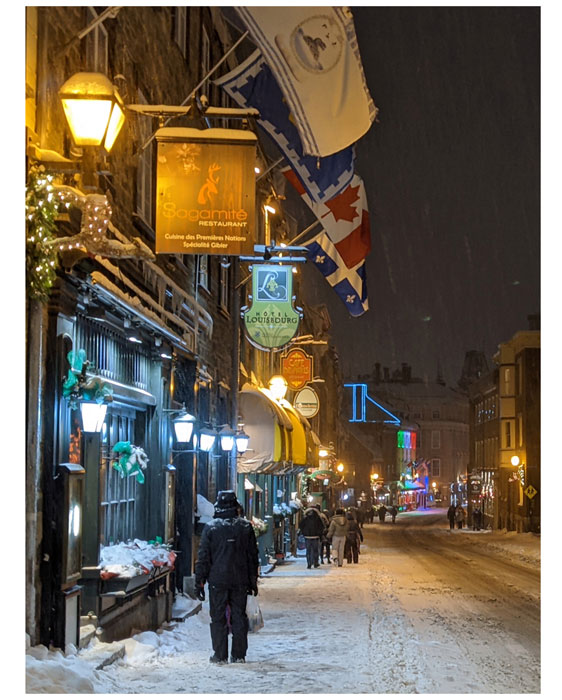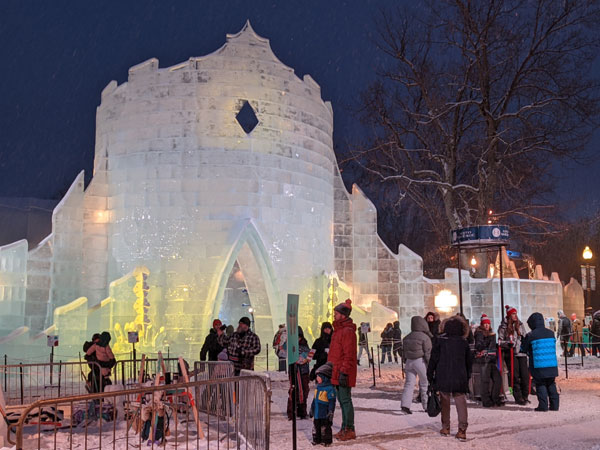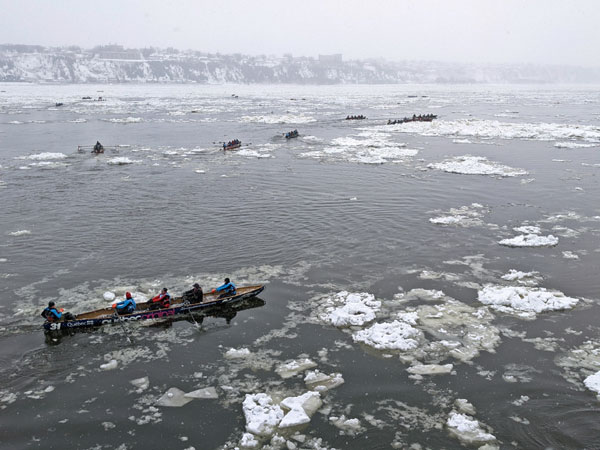
The citizens of Ville de Québec spend half their lives under snow. That’s far too long to hibernate and await spring, so they fight the winter blues with sports such as skiing and snowshoeing. Another survival tool is the world’s biggest winter carnival: the annual Carnaval d’Hiver, an international festival to lighten the mood in the icy darkness.
The city has sponsored the official carnaval since 1955, though various informal festivals date back to the 19th Century. Today, it is held in late January or early February, featuring ten days of outdoor events and drawing visitors from around the globe.
Québec itself – the city, not the province – dates to 1608. The original Old Town (Vieux-Québec) is divided in two. The Upper Town (Haut-Ville) sits atop Cap Diamant, a promontory above the St. Lawrence River, encircled by the last remaining city walls in North America. The old fort alongside, the Citadel, is still a functioning military base. The other half is the Lower Town (Basse-Ville), below the cliffs of the cape along the St. Lawrence. It hosts a large port. Just behind the Upper Town, outside the walls, lies the modern downtown, with a population of about 550,000.
Should you attend, carnaval requires a few accoutrements. The first, absolutely necessary, is an effigie, the small plastic figurine you purchase and hang from a loop on your coat. It is made in the shape of Monsieur Bonhomme, the snowman-like mascot of carnaval, and allows the wearer access to the various areas and events of the festival. As long as you’re buying an effigie at your hotel or a local store, you might as well get an arrow sash (a wide, colorful, traditional cloth belt tied around the waist), a cane (a long, hollow, plastic walking stick with a screw-top, handy for carrying liquor), and a flute (a red plastic horn similar to the vuvuzela, making the same annoying sound). So equipped, you should then don all the winter clothes you own with no account of your appearance. Wind chills of -20 F. are common during carnaval.
Start at the noble Chateau Frontenac, the most imposing edifice in the city, and walk southwest down Rue Saint-Louis. You’d think you’re in a medieval European city on this narrow avenue between stone buildings, and the streets and sidewalks are always snow-covered. There’s no way to keep them clear for long, a barista explains while making my cappuccino in a nearby café. There are many fine cafés on the streets of Old Town, and the shops are cheerfully decorated with flags, Christmas lights, and evergreen wreaths with crimson bows. The streets are crowded and everyone is heading for the Saint Louis Gate in the city walls at the end of the avenue.

Beyond the gate and to your right is Esplanade Park, now converted into a wonderland of ice. The most obvious addition is a castle, three stories high and made from thick blocks of transparent ice which glow slickly under multicolored spotlights inside. Within are various rooms where carnaval-goers view ice sculptures or play ice percussion instruments.
At the center of the park is an outdoor bar constructed entirely of ice, serving hot toddies in tin cups and various liquors, including the carnaval favorite: caribou. I’ve never seen it sold outside carnaval. It is composed of red wine, whiskey, maple syrup, and unnamed winter spices. The bar serves shots of it in ice glasses; Yours Truly hesitated to touch it to his lips, for fear of freezing to it, but apparently the alcohol lowers the freezing temperature of your skin and there were no mishaps. For many, the mishap comes the next morning with the hangover from the sweet stuff.
Within walking distance of the gates are numerous activities which vary from one year to the next. There is usually an ice-skating rink; I have also seen an adaptation of the popular climbing walls, but this version is sheer ice, climbed with crampons and an ice-axe. There are demonstrations of native arts and dance. Certain brave souls strip down to their bathing suits and jump into a snow bath, probably fortified by caribou. There are inner-tube snow slides down the hill by the Citadel, and ice sculptors working all around the Old City, leaving their creations along the streets. Some years, the festival includes dog sled races and soapbox derbies. A costumed Monsieur Bonhomme is of course in attendance, circulating among the revelers and happily joining their selfies.
Carnaval foods are not the sort you’d eat every day and live for long. One example is beaver tail, a thin pancake of fried dough shaped like its namesake and slathered with ice cream or maple syrup or whatever strikes your fancy – I prefer Nutella. Little shops and stalls sell these and other confections all around carnaval. A family favorite is the block of snow onto which a volunteer pours maple syrup and quickly twirls it around a stick as it freezes, forming a maple popsicle (tire sur la neige), which is possibly the most Québecois thing imaginable.
But the subzero revelry works up an appetite for something heartier than festival treats. Wandering the snow-covered streets within the walls, one finds no industry, but only cafes, restaurants, boutiques, hotels, and pubs – a tourist wonderland suspended untouched in time and the perfect place to satisfy your appetite. Québecois cuisine springs from the French, but with recipes adjusted to locally-available produce and further developed by waves of immigrants, each making its own contribution. Restaurants are packed during carnaval, but Québec sports so many of them that you soon find a table. Inside, the windows are fogged by the packed revelers and the place cluttered with doffed winter clothing. It’s loud with a lot of laughter. This is where you’ll find flavorful smoked meat sandwiches, a contribution of Montreal’s Jewish immigrants. Crepes, sweet or savory, are popular, as is poutine, the Québecois pub grub staple. A basic poutine is cheese curds and gravy over French fries, almost invariably enjoyed with beer. Today, poutine comes in dozens of variations, none of them healthy. I had one in Basse-Ville that included bacon-wrapped pork sausage and suckling pig.
In the evenings – when it gets cold – crowds gather for two of the most popular events. The first is a series of outdoor concerts by national and international acts. The second is the nocturnal parade through Haut-Ville. It is nothing like your standard holiday parade. The floats look like they’ve been plucked from Cirque de Soleil, with fantastical scenery, lighting, and costumes. Bands and dancers perform, heedless of the cold, and giant puppets stroll like surreal visions down the snowy street past thousands of cheering spectators.
The parade is surpassed only by the greatest of all carnaval traditions: the ice canoe (canot à glace) race. This sport harkens back to Québec’s colonial days, before bridges spanned the Saint Lawrence. Canoes were used to ferry supplies across the river, even in winter when it is choked with ice. The government ran an annual race to determine which crew would receive the lucrative contact to carry the mail.

Today, the “canoes” are eleven-foot racing shells, rowed by teams of five. These teams belong to an amateur league which hosts several races a year, the carnaval race being the most prestigious. Around forty teams participate each year. The canotiers follow a circuit from the wharves in Basse-Ville into the mist-shrouded Saint Lawrence. This is not simple rowing. The river is covered in ice and slush, and the canotiers must navigate through the floes in the strong current. If passing between them is impossible, they run the canoe up onto the ice floe, leap out, and drag the boat across until they reach water again. Occasionally, what looks like solid ice is really slush, or else the ice breaks or tilts, and straight down they go. Hopefully, they have a firm grip on the gunnels if that happens. A canotier I met in a bar one year told me that he’d never heard of anyone dying in the race, though he chalked it up to the skill of the canotiers, not the unforgiving river. Thousands of people line the wharves to cheer this display of authentic Québecois madness.
Imagine telling your spouse or significant one that you’d like to forego Key West this winter and go north instead, and not for skiing. Your hesitation is understandable. But you might add that four hundred thousand people decide to do just that every year, nearly doubling the population of Ville de Québec for ten days. Colorful Carnaval d’Hiver is one of the most idiosyncratic and celebrated festivals in the world and certainly of the winter. If you experience it just once, you might become a devotee.

09/26/2023
10:00:30 AM